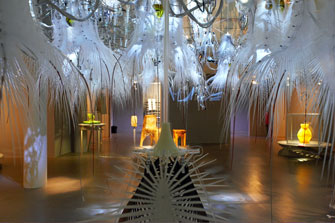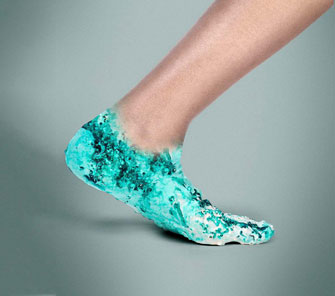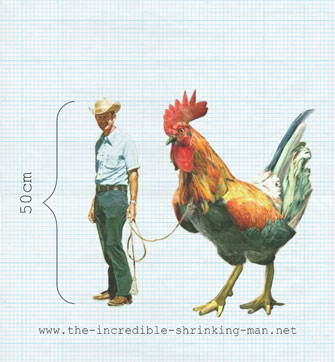
“Radiant Soil,” by Philip Beesley. © Fondation EDF/L. Lecat
Imagine a science fair with aesthetic flair. The exhibition “En Vie – Alive: New Design Frontiers” at the Espace Fondation EDF presents a selection of 34 highly diverse projects ranging from the poetic to the provocative that show how biology might be incorporated into design in the future and used to change our lives.
Wander in on a sunny day, and you’ll be stunned by the darkness when you open the door. Once your eyes adjust, you find yourself surrounded by a feathery white world of what seem to be sci-fi creatures floating in the air. Eerily interactive, these long-fingered medusas raise their plumes as you approach. If you gently squeeze the hanging wires, the plumes rise and hover, and lights begin to sparkle.
These “creatures” are part of “Radiant Soil,” an elegant installation designed by Philip Beesley to mimic a living metabolism. Described as near-living architecture, it beckons to visitors like the spider inviting the fly into her parlor.
You will not be ensnared in this silken web, but be warned that this exhibition is not an easy, let’s-take-a-quick-look experience. The sophisticated projects that follow – developed by teams of scientists, designers, architects and artists – demand that you engage your brain and study the accompanying texts to understand their meaning.
The exhibition is structured around five themes that investigate how the living world can lead to new design frontiers and new ecological models.
The Plagiarists
The first series, handsomely arranged in the main room, features the use of manmade technologies to imitate processes and behaviors found in the natural world. “eSkin” is an example of adaptive architecture, which investigates the possibility of buildings made of responsive materials and sensors inspired by living organisms that are both aesthetically intriguing and ensure minimal energy consumption. “Pearling” uses chemistry to develop a technique for the production of manmade pearls.
The New Artisans
Taking as their theme “nature as co-worker,” the next set of creators has managed to coerce bees, bacteria, algae, plants and fungi into assuming various shapes to make ordinary consumer goods. Did you know that fungal tissue can bind, solidify and harden into any chosen form? Once dried, the resulting material is lightweight and strong. Yamanaka Furniture presents a chair grown from living fungal cells, which is both fascinating and a bit revolting.
It took 60,000 bees two months to make another exhibit, “Vessel n. 1,” a huge honeycomb vase, while the “Biocouture Shoe” is the world’s first “grown” shoe.
Visitors can also watch a video of garments made of fabric grown from microbes and touch swatches of this material, which looks like fruit roll-ups and feels like rubbery leather.
The Bio-Hackers
These extreme bioengineering projects based on cutting-edge science offer a glimpse of what engineered living organisms might be able to do for our daily lives in the future. One example is packaging that creates its own contents when you add a liquid, thus eliminating packaging waste.
Another project presents E. chromi, a genetically engineered bacterium developed by a group of scientists and designers that changes color to indicate the presence of a toxin in water. A future application might be a probiotic yogurt containing E. chromi that colonize your gut and identify chemical markers of disease. If a disease is detected, the bacterium will release a bright, easily recognizable color you can check for in the privacy of your own home… by looking precisely where intestinal by-products typically end up. (The group’s Web site offers a clear and interesting explanation of this project.)
The New Alchemists
In this section, multidisciplinary science projects explore the merging of biology, chemistry, robotics and nanotechnology to create new hybrid organisms. Teams have combined living (biological) with non-living (electronic and chemical) technology to imagine, for example, nanomagnetic plants, a robotic jellyfish drone and an artificial reef that could be grown under the sinking city of Venice to solidify its foundations.

“Amoeba Shoe” (2012), by Shamees Aden. Photo: Sam J. Bond
Even if you are not a jogger, the green-marbled “Amoeba Shoe” will catch your eye. A genuine second skin that takes the shape of its wearer’s foot, this living technology adapts in real time to the activity of the runner and adds extra support in high impact areas. It was developed using materials derived from protocells, which blur the gap between the living and the non-living, and make several appearances in this exhibition.
Les Agents Provocateurs

“The Incredible Shrinking Man” (2013), Arne Hendriks. © Arne Hendriks
Things lighten (or darken, as the case may be) up as you reach the fifth and final theme, Les Agents Provocateurs. This is conceptualized and imagined nature – partly wacky and partly scary. We lingered long to enjoy the quirky humor of “The Incredible Shrinking Man” installation. Just think: if human beings measured only 50 centimeters, one chicken could feed 100 people.
“Skinsucka,” a design statement attacking consumerism, consists of tiny insects that glide across the skin and munch on dead squamous cells. In a similar way, “Cactus Project” (a cactus that’s been genetically engineered to grow human hair instead of prickly needles) is fascinating and creepy at the same time. Like the other projects here, these two encourage debate about ethical issues related to living technology.
If you like science fairs, you will find this one rich in food for thought. Even if you don’t “get” every project (and I did not), the exhibition will delight your eyes as it expands your mind, and you will probably forgive the fact that the thread holding it all together is not always easy to grasp.
Espace Fondation EDF: 6, rue Récamier, 75007 Paris. Métro: Sèvres-Babylone. Tel.: 01 53 63 23 45. Open Tuesday-Sunday, noon-7pm. Closed Monday and holidays. Free admission. Through September 1, 2013. www.thisisalive.com
© 2013 Paris Update
Favorite